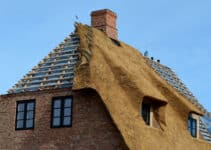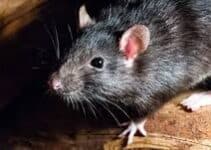There’s nothing easier on the eye than a freshly thatched cottage, is there? Thatch has become a mark of authenticity that a historic cottage is the ‘real deal’. And can a village claim the name without at least one thatched cottage in its environs?
Well, yes, it can. But somehow a village doesn’t seem as authentic without at least one thatched building in its midst.
Thatched buildings are the stamp that hallmarks a village as a ‘ye olde’ part of Britain’s rich history. But keeping a thatched roof maintained and cleaned is essential to its natural beauty. Lets dive into how to keep your thatched roof in stunning form.
Why is Cleaning Your Thatch Roof Important?
Many people dream of escaping to the country. And part of that rural idyll might include buying the picture postcard ideal of a rural property – that’s one with a thatched roof, of course.
And while there’s no denying the beauty and historical value of owning a property with thatch, there’s also denying that it’s a costly thing to maintain.
As with any part of home maintenance, prevention is better than the cure. So, cleaning and maintaining your thatch regularly is a surefire way of prolonging its life.
Norfolk Reed has a lifespan of 50 – 60 years. And other popular thatch – Combed Wheat, Long Straw or Water Reed from Eastern Europe can last 55 – 65 years.
But you’ll only get the maximum lifespan out of your thatch if it is well-maintained.
And with the average price of re-thatching in the UK ranging from £33,000 to £67,000, no further incentive is needed than to do just that.
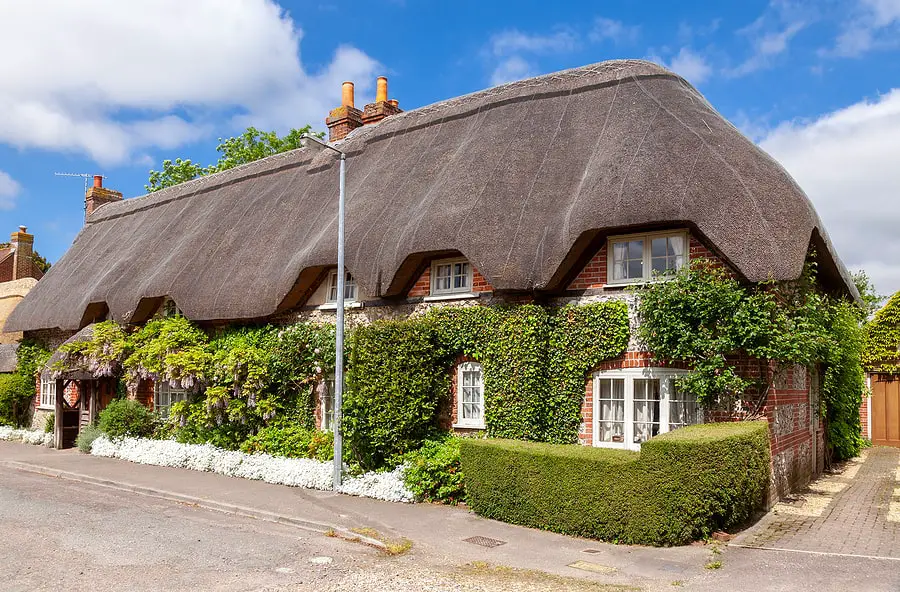
Some of the cleaning and maintenance you can do yourself. Or if you have the budget and the inclination, you can hire contractors to do the work for you.
Of course, depending on the type of property and thatch you have, hiring contractors might be your only option to protect the integrity of your thatch and for health and safety reasons.
But let’s look more closely at how to clean your thatch.
How to Clean a Thatched Roof
Through regular cleaning you can preserve the life of your thatch. And regular cleaning can also help save money long term by preventing small problems from becoming larger problems.
But how do you go about it?
As with all aspects of roofing maintenance, cleaning thatch is probably best left to the professionals. They have already invested in the equipment and training necessary to do a speedy and efficient job.
But not everyone has the budget for annual thatch care or they may prefer to do the job themselves. Either way, here are some ways you or your contractor can clean your thatch.
Thatch Brushing (or Combing)
A thatch maintenance task that is often required is ‘brushing’. There are a number of methods that are used to comb a thatched roof. But let’s start with learning what ‘brushing’ is.
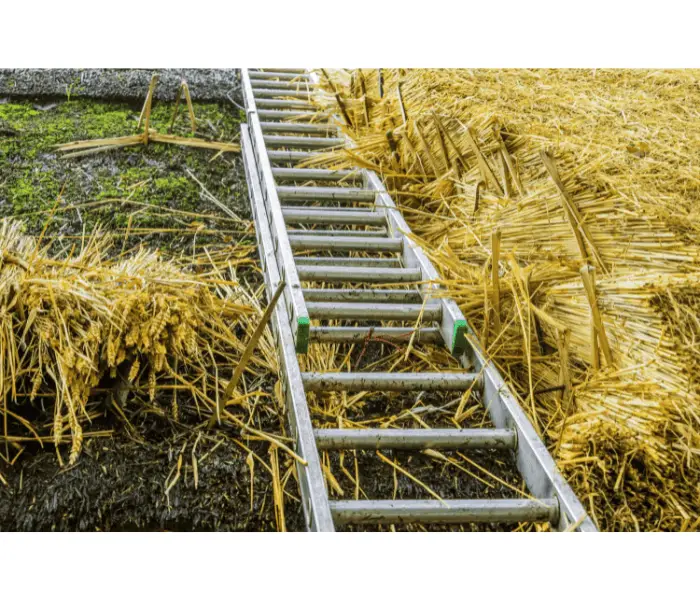
What is Thatch Brushing?
Brushing is the method of removing the ends of the thatch from the roof. And it should be done several times during the lifetime of the thatch to prolong its lifespan.
It should be done more often if your thatch is prone to dampness.
Why is Thatch Brushing Necessary?
This type of maintenance is necessary because, like all organic materials, the ends of the thatch will slowly start to rot.
The ends are the most exposed to weathering and other environmental factors, so this is naturally the part of the thatch that is going to require the most maintenance. Plus, the ends will hold more water once decay has set in.
Removing the ends of the thatch will allow air and sun to dry out the undamaged parts that lay beneath the rotten outer parts.
While it might seem that you’re then exposing a new layer of thatch to the elements, it does prevent greater wear and tear in the long run.
This is because by removing the damp and decaying parts of the thatch, you’re preventing the excess moisture from penetrating deeper into the thatch.
You want to avoid moisture penetrating to a place where air and sun are less likely to reach and help it to dry.
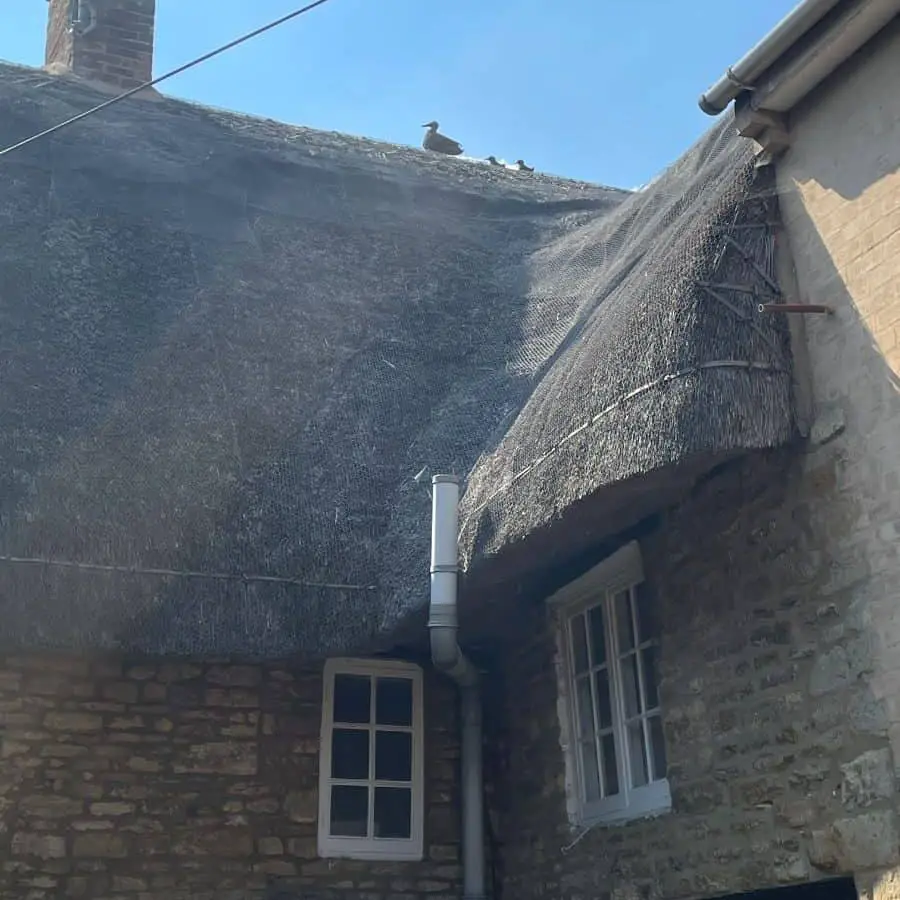
How Often Should Thatch Brushing Be Done?
How often you have your thatch brushed will depend on a number of factors including the type of thatch, your location, the environment and if there is unexpected damage to the thatch.
Roughly, though, brushing should be done between 3 and 4 times in its lifetime. There wouldn’t be enough thatch left for many more brushing after this point, so rethatching would be necessary.
This could mean that some thatched roofs might need brushing every 8 years and some can go as long as 15 between brushings.
How To Brush Thatch
There are a variety of different tools that professionals use which are designed specifically for the care and maintenance of thatch.
But if you’re intending to brush the thatch yourself, you could use the manual method of using pruning shears.
The process requires you to pull out sections of the thatch prune the ends and then push them back into place. Unless you’re an expert you can probably see that this method may disturb the integrity of the remaining thatch.
Alternatively, you could use a hedge trimmer. Using a hedge trimmer doesn’t require you to remove or replace sections of the thatch.
Although it does require brushing back into place. There is some potential that the edges of your thatch may be split or not be as cleanly cut by a hedge trimmer as by professional methods of trimming.
Needless to say, both options are time-consuming to DIY and will probably require you to hire a scaffold for safety. Your success will also depend on the extent of the damage and the type of thatch you have.
Remove Moss and & Algae
Moss and algae are a sign that your roof doesn’t get enough sun or wind to dry it out and, as a result, it’s damp enough for algae and moss to thrive. And any thatched roof owner knows that a damp thatch is the last thing you need.
You can control algae with the use of an algaecide. This is sometimes called a ‘soft wash’ and involves chemicals being sprayed or ‘washed’ onto the thatch which both kills the moss and algae and prevents its regrowth.
The protection is washed off by rain over time, though, so reapplying is necessary and best done during the summer months.
Moss can be removed manually from your thatch. It can be picked off if the moss and thatch are low enough for a ladder. Harder-to-reach balls of moss can be carefully raked off.
But removing moss, while essential, is only cosmetic and won’t remove the cause of the problem: dampness. So, to learn more about removing moss from thatched roofs read our article here.
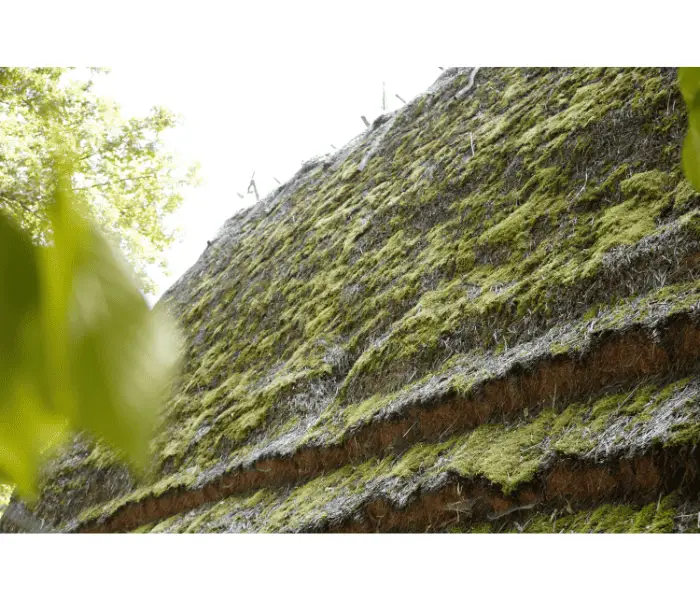
What Maintenance Does a Thatched Roof Need?
A thatch roof will require its owner to stick to a regular maintenance schedule if they want to retain its practical and aesthetic qualities.
Once implemented, large-scale damage to your thatch will be a thing of the past (unless there’s an accident or a storm).
So here are some best practice tips to get your thatched roof maintenance regimen started:
Inspection Schedule
Create an inspection schedule. This can be mentally stored if you have a fine mind. For those of us less blessed in the memory department, a calendar date often works to imbed a good routine.
Check the Integrity of Your Thatch – Especially Corners, Gullies, Valleys
While inspecting your thatch, look carefully at the thatch to make sure its integrity is intact. Look carefully at the corners that could have been lifted by strong winds or animals.
Pay particular attention to the eaves, especially where they meet the wall, to make sure the thatch is not holding moisture there. Check gullies, and valleys for debris and for dark marks that could indicate damp.
Check for Moss and Algae
Moss and algae are considered by many to pose the worst threat to your thatched roof. Partly because moss can hold a huge amount of water which will rot the thatch if left unattended.
The added weight of damp moss, if it covers a significant area, will also have an adverse effect on the thatch over time.
Check the Capping or Ridge
Some thatched roofs are capped with a mixture of cement and sand to form a rigid cap. If this is cracked or damaged it’s an easy way for water to penetrate into the thatch.
It could then start to rot the thatch under the capping as well as leak water into the supporting timbers.
If there’s no capping but the ridge is damaged, it’s still a priority to get it patched.
Running Repairs for Thatch
Maintenance will require smaller running repairs. So after checking what needs to be done, you need to act on those finds by making repairs– or hire a contractor to do them for you.
Cleaning Your Thatch
Cleaning your thatch, using the advice above, is probably your first priority.
Controlling Animals
Everyone loves a thatched roof including animals. In fact, thatch offers a perfect nesting site for many species of birds and small mammals.
If there are any holes in your thatch they are either a sign that you have a nesting site or a point of ingress for animals that have made your thatch their home.
You want to avoid animals having easy access to your thatch, roof spaces and the rest of your home. Check that animals are not currently nesting in your thatch.
And if they are, they can be humanely removed from your thatch by pest control specialists, if the situation requires. After this, quickly address the damage to your roof by brushing or patching the area.
To deter small mammals like mice it’s always a good idea to keep food sources and waste out of sight and smell.
Secure bins as far away from your property as possible is also another way of creating distance between your thatch and unwelcome tenants.
The same applies to bird tables. Avoid them if you can or site them as far as possible.
Dressing or Compacting the Thatch
After cleaning and addressing any damage to the thatch caused by animals, you may want to improve the integrity of your thatch by regularly compacting or dressing your thatch.
Being exposed to all sorts of weathering as well as accidental damage, thatch can lose compactness. And without this compaction, thatch is more prone to water ingress or further wind damage.
The compactness can be restored by replacing or adjusting the tension on the twines from inside the roof. This is best done by a specialist who can use the right fittings for your thatch type.
After compacting the thatch, or if the damage to the thatch is slight, dressing can be done.
Dressing is completed through the use of a leggett which is a paddle-shaped tool with notches to drive the thatch into place. This restores the thatch’s integrity and significantly improves its longevity.
Re-ridge or Repair the Capping
It’s not surprising that a thatched roof will require a new ridge more often than rethatching – it’s the most exposed part of the roof, after all.
Re-ridging will need to be done every ten to fifteen years and will usually cost about 25% of the full thatch quote from your thatcher.
During re-ridging, the net will be removed and the old thatch taken back to a firm base. A new thatch ridge is then laid at the apex of the roof. The ridge will then be dressed and brushed.
Many thatched roofs in the UK don’t have a hard capping added to the ridge. But if your thatch has got a cap, you may need to repair or replace it from time to time.
As before, unless you are very confident in your thatching skills and you have the right equipment, both these jobs should be undertaken by an experienced thatcher.
Patching
There are a variety of different reasons why your thatch might be disturbed or damaged. Even the best laid thatch can’t withstand freak storms or the most determined animals.
And provided that the damage isn’t the result of an underlying problem with the roof or thatch, it can repaired with a patch.
A patch is simply the replacement of the damaged portion of thatch with new thatch but may not require the thatch to be taken right back.
The patch is best done with the same materials as the rest of the thatch but you have to be prepared for the patch looking a different colour.
Repair Flashing
Whether your flashing is made of cement or lead, it may come away from the chimney or start to gape where the flashing meets the thatch as it settles over time.
Flashing is usually replaced during re-ridging but if it becomes damaged, it shouldn’t be ignored as it will be a way for water and animals to gain deeper access and cause more damage.
Lead flashing is more expensive but less prone to damage. They rarely need to be replaced after each re-ridging. But keep an eye on their placement.
Manage The Surrounding Environment
Any changes to the environment that surrounds your house that might affect the health of your thatch should be addressed.
If trees have grown up around the house that block out light and air from the thatch they should be cut back. Any foliage or creeping plants, such as ivy or clematis that might have grown up into or onto the thatch, should be trimmed.
Needles or fallen leaves should be removed as often as possible during the winter months but certainly before they have had a chance to decay significantly, as they will trap and hold water close to the thatch.
Obviously, not all trees pose a threat to thatch. Some trees can act as a partial windbreak which can protect the thatch roof from storms. Common sense is called for here.
Your priority is to make sure that your thatch has optimum access to light and a drying breeze. And anything that prevents your thatch from drying out thoroughly should be dealt with.
Don’t forget that any building modifications should take the thatch’s needs into consideration. Don’t allow an extension to block out light or create added moisture for the thatch unless you have solutions that will avoid the consequences.
Repair Unintentional Damage
If you or your contractor have caused unintentional damage during repairs or re-thatching, solve the problem asap. Most professional tradesmen will not leave a job having created damage – they’ll make good problems they’ve inadvertently caused.
But if a problem has occurred as a result of work completed on the roof after your tradesmen have left, make sure you contact them swiftly to repair the damage.
Are Thatched Roofs Expensive to Maintain?
The answer to this question is not straightforward. If you have bought a house with a poorly maintained thatched roof or you have neglected your thatch then it’s unlikely to be cheap to put right.
It’s less expensive if your roof is new or in good shape and not too old.
Thatch Roof Maintenance Cost
Giving specific parameters about the cost of thatched roof maintenance is counterproductive. Why? Because of the cost of maintenance will depend on the following factors:
- Experience and expertise of ant contractor you use
- Age and condition of your roof
- Size of your thatched roof
- Type of thatching material
- Shape of your house (logistic arrangements)
- Environmental factors – including the surrounding environment
- Age of your property and any protection, such as listing, that’s involved in renovation
- Cost and availability of thatching tools and products
There are, however, many maintenance tasks most able-bodied people can do themselves at either no cost or for very little outlay.
Without a doubt, it’s a privilege to have a property with a thatched roof. You have bought a piece of history and a work of art.
But like all luxury items, they need specialist care to maintain their integrity. Thatch is no different.
And with the right cleaning and maintenance, your thatch can continue to delight many generations to come.
